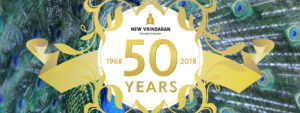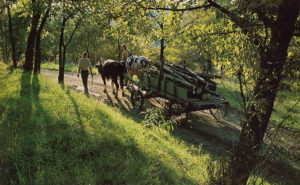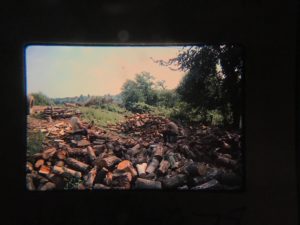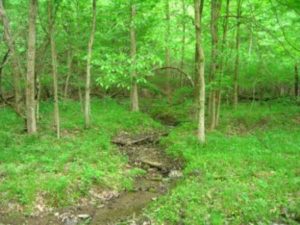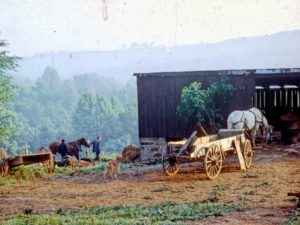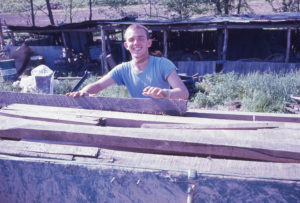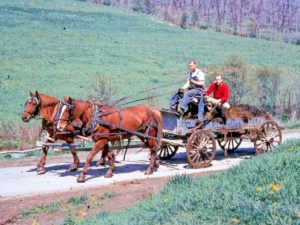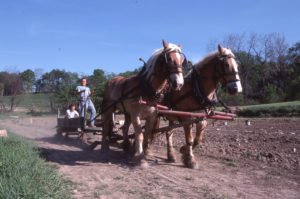NEW VRINDABAN DAYS – CHAPTER 6
NEW VRINDABAN DAYS
As New Vrindaban enters its 50th anniversary (1968 to 2018), I wrote this series of articles for the Brijabasi Spirit in an attempt to give the reader not only an “understanding,” but more importantly a “taste,” of what life in early New Vrindaban was like – through the stories of one devotee’s personal journey.
The title of the series, “New Vrindaban Days,” is in tribute to the wonderful book “Vrindaban Days: Memories of an Indian Holy Town” written by Howard Wheeler, Hayagriva Das. He was one of Srila Prabhupada’s first disciples, a co-founder of New Vrindaban, and, a great writer. As with Hayagriva’s book, this series focuses on a period of time in the 1970’s.
I would also like to acknowledge and thank Chaitanya Mangala Dasa, for spending untold hours assisting me in refining my writing for your reading pleasure.
I have been asked to describe certain aspects of early New Vrindaban Community life such as the nature of the austerities, what it was like for a new person coming here, cooking, anecdotes about particular devotees, etc.
I attempt to tell these stories in some semblance of a chronological order, beginning with my first meeting with devotees in 1968, leading to my arrival in New Vrindaban in late 1973 and carrying through to the official opening of Srila Prabhupada’s Palace in 1979.
This article describes my day to day service activities after only a couple of weeks of living in New Vrindaban.
Advaitacharya Dasa
CHAPTER SIX: IN THE WOODS
In the first few weeks I am in New Vrindaban I not only work in the wood shed but I also go out into the woods every few days to help to bring the wood in.
Community woodsman Romaharsana Das stands about 5’5”. He wears a big western hat, muddy jeans, heavy boots, a green sweatshirt, and has a large bowie knife dangling from his belt. He is in his thirties, has been a devotee for years, and has even had direct association with Srila Prabhupada. He is not a city boy. Instead he talks with a country boy twang and revels in the fact that he is a mountaineer kind of guy.
On this day we are a half a mile back in the woods. In Romaharsana’s hands he holds the reins which control two big white horses named Prince and Molly.
“Boy, you see that tree lying over there? Go on over and see if it’s green.”
I walk to the felled tree but, like all the other trees both standing and lying on the ground, it looks “brown” to me.
“Well boy, is it green?”
I shake my head no, too embarrassed to tell him that the tree is obviously brown.
“Boy, how can you tell if the tree’s green or not, if you haven’t even touched it?”
Now, I am completely bewildered. I’m supposed to tell the color of a tree by touching it? I bend down and begin stroking the tree with my hand. It still looks brown to me.
“What the hell are you doing? Come over here and hold on to these horses.”
I walk over and take the reins, allowing Romaharsana to inspect the downed tree.
“Oh yeah, this baby ain’t green. This baby is nice and dry for Krishna.”
Now, I’m even more confused. He’s repeatedly asked me the color of the wood but now he’s commenting on the wetness of the wood. The downed tree has snow all over it so the fact that he is referring to it as dry is beyond me.
“Go on down that hill and tell me what those trees laying on the ground down are.”
I climb down the steep bank to the felled trees below. Checking them out, I yell back to him.
“They’re trees.”
“Boy, what kind of trees?”
“Big trees.”
“Are they locust?”
Are they locusts? What the hell is he talking about? “No, they’re not locusts. They’re trees.”
“Boy, get up here and hold onto these horses.”
Again, I take the reins and Romaharsana makes a closer inspection. After climbing back up the hill he takes out his wrath on me.
“Don’t you know nothin’ about the woods? You don’t even know “green” wood. You don’t know locust. How you supposed to live in New Vrindaban when you don’t know nothin’ about nothin’?”
Romaharsana begins educating me. “You see that tree right there? Do you know what kind of tree that is?”
“Prabhu, I’m from Brooklyn. I just know that trees are trees. I know “A Tree Grows in Brooklyn,” but I don’t have any idea what kind of tree it is. And, as far as I know all trees are brown.”
“Well, you ain’t in Brooklyn no more. You wanna be self-sufficient you have to learn these things. Look here. You see that tree right there? That is a locust tree. Locust is good hard wood.”
“All wood seems hard to me.” I say.
“Don’t be stupid. You want hard wood cuz hard wood burns hot.”
Now, I’m even more confused. All wood isn’t hard and all fire isn’t hot. I foolishly think it must be some kind of ancient Vedic knowledge that I am just now being introduced to. Perhaps, even some kind of mystic riddle I am supposed to meditate on in order to achieve enlightenment.
Over the next days in the woods Romaharsana continues to teach me. “You can tell the different types of trees by looking at the bark.”
I am twenty years old and being from NYC I guess I kind of know that there are different kinds of trees, but I have no idea of how to tell them apart. Basically to me a tree is a tree, is a tree, is a tree.
“Locust trees have bark with the bigger grain and bigger veins. The bark of an Ash tree is much tighter and smaller. Green wood is wood that has not dried out yet and still has a lot of sap in it. Dry wood is the opposite. It’s not only hard to start a fire with green wood it’s also dangerous. If you burn green wood eventually the sap will stick to the inside of the chimney and it could catch fire inside the wall.”
Romaharsana seems to know everything about the woods. He points out places where herbs and edible plants will be coming up in the spring. He shows me places he swears will soon be full of berry bushes. He climbs trees. He cuts down trees. He wraps large chains around the felled trees and uses the horses to drag them out of the woods. Although I am far from being any kind of woodsmen, I am starting to see city life in my rear view mirror and a life of self-sufficiency, based on simple living and high thinking, in front of me.
Besides his knowledge, obvious appreciation for New Vrindaban, and his life as a disciple of Srila Prabhupada, Romaharsana loves to talk about Krishna. Between his tidbits about the beauty and abundance of the forest, and his critiquing of my inadequate skills, he is always talking about Krishna.
“In New Vrindaban Krishna is hiding behind every tree! That’s why I love it out here in the woods. Krishna is everywhere in New Vrindaban, but he’s especially out here in the forest. He goes out into the forest every day with the other cowherd boys. And, you know what he does at night, boy? He goes out into the forest with the cowherd girls.” Saying this he gets a giant grin on his face. “Yeah, I love being out in the forests of New Vrindaban.”
Romaharsana is much older than me and is still a single man. Although he loves being in the woods, loves Prabhupada, and loves Krishna, there still seems to be some other kind of “love” that Romaharsana is requiring as a remedy to counteract the symptoms of one of the most prevalent maladies found in New Vrindaban.
I’m not sure the malady is described in medical journals but in New Vrindaban it is generally diagnosed in the following way:
“What’s wrong with Romaharsana?”
“He’s agitated.”
Although the symptoms are varied – sleeping in, not coming to work, spending days in your room, not getting up in the morning for the services, not chanting your rounds, etc. Once the malady is diagnosed there is ultimately only one remedy.
While Romaharsana’s “illness” is having multiple negative effects around the community, I am appreciating his daily absence. If there is no Romaharsana, then there is no wood coming in. If there is no wood coming in, there is no wood for me to cut in the woodshed. If there is no wood for me to cut in the woodshed, Bhakta Emil is on a fast track for taking it as easy as he can trying to make himself look active doing busy work or disappearing to my room to “read Prabhupada’s books,” also known as sleeping.
Talk in Kirtanananda Swami’s cabin is that they are thinking about getting Romaharsana married to cure his “agitation.” In the Hare Krishna movement there is no acceptable mingling of the sexes and marriages are not accomplished by two people who get to know each other and their common interests connecting over a dinner date or seeing a movie together. Instead someone getting married starts with the Swami picking up a copy of the community census and going down the list to see which single woman might be a good match for Romaharsana.
The whole idea behind the process of Krishna Consciousness is rooted in surrender. For many of the devotees, both male and female, the greatest act of surrender they will be faced with is being asked to marry someone that they don’t even know.
While this is going on, I get word that the Swami wants to see me in his cabin.
“Hare Krishna, Maharaja. They say you want to see me?”
“What’s going on with the wood, Bhakta Emil?”
“Well, you know, I’m just waiting for Romaharsana or somebody to drag in some wood so that I can cut it up.”
In my mind I have presented an unarguable argument.
“Why don’t you just hitch up the horses and go out and get the wood yourself?”
“Me take the horses out? I really don’t know anything about driving work horses, Maharaja.”
“I’ll send Kasyapa to show you a few things. It’s not very difficult. It will only be until Romaharsana gets it together.”
The next day I am at the horse barn early in the morning where I am met by the brahmacari, Kasyapa Das, who drives another team of horses. After showing me how to clean the horses, shovel out the stalls, take the horses for their morning drink of water in the creek, harness the team up, and explain some of the equipment to me, he takes me along with him and his team Tom and John.
While going through the motions with Kasyapa and his team, the words of the Swami reverberate between each of Kasyapa’s warnings.
Kasyapa: “You have to be really careful when you do this because if it goes wrong you could get killed.”
Swami in my head: “It’s not very difficult.”
Kasyapa: “If you don’t do this right the horses can get killed.”
Swami in my head: “It’s not very difficult.”
Kasyapa: “If that piece of equipment swings the wrong way it can break the horse’s legs.”
Swami in my head: “It’s not very difficult.”
Swami in my head: “It will only be until Romaharsana gets it together…”
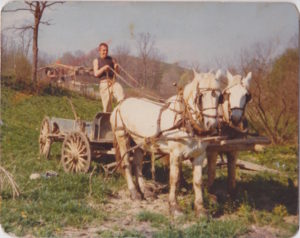
Advaitacarya with a team of horses, Prince & Molly, at Bahulaban, mid 1970s (note the partially completed barn in the background, which would put the photo in 1974 or 1975).
Fortunately, for Romaharsana, his “malady” is soon relieved when he is married to the brahmacharini, Vajresvari Dasi. Vajresvari seems to me very “city” to Romaharsana’s very “country,” and I hope the match will now mean that I can return to life in the woodshed while Romaharsana returns to driving the horses.
Unfortunately, for me the saying frequently said all over the community, “Man proposes and God disposes,” lands squarely on my head when the Swami decides to increase the size of the “plough” department and keep me in the horse barn.
Although a couple of devotees living in various places across the entire terrain of New Vrindaban may have vehicles of their own, there are only two “community” vehicles in Bahulaban. Whatever “junk” car the Swami might be getting around and an old red Farmall tractor. This means that everything that might need to be moved from here to there – trash, manure, hay, supplies, and other commodities too gross to mention in print have to be moved by the horses.
Just preparing the horses for their workday takes over an hour between feeding, watering, cleaning, and harnessing. This now means my workload from life in the woodshed has been increased tenfold. This verbose New York City kid would like to be complaining twenty four hours a day, but unfortunately my fellow horse driver and teacher Kasyapa seems to enjoy socializing even less than the horses. Unless, of course, it is actually socializing with the horses, with whom he remarkably seems to be able to communicate.
My fate is sealed: Bhakta Emil – horse driver in training – and plough department member.
Did you miss any of the previous chapters? Click the links below to catch up:
Chapter 1: Every Journey Begins With a Single Step
Chapter 2: Srila Prabhupada – Jaya Radha Madhava
Chapter 3: Captured by the Beauty of Sri Sri Radha Vrindaban Chandra
Chapter 4: Fired Up – We Depend On Sri Sri Radha Vrindaban Chandra
Chapter 5: The New Vrindaban Landscape – January 1974
Stay tuned for Chapter 7: Prasadam
